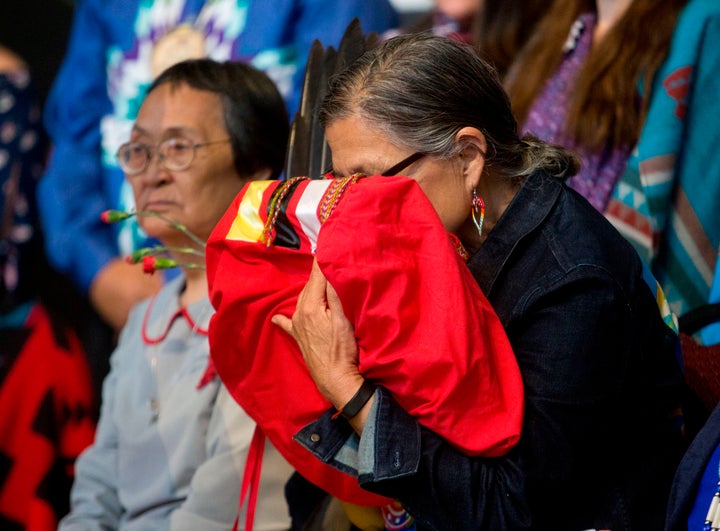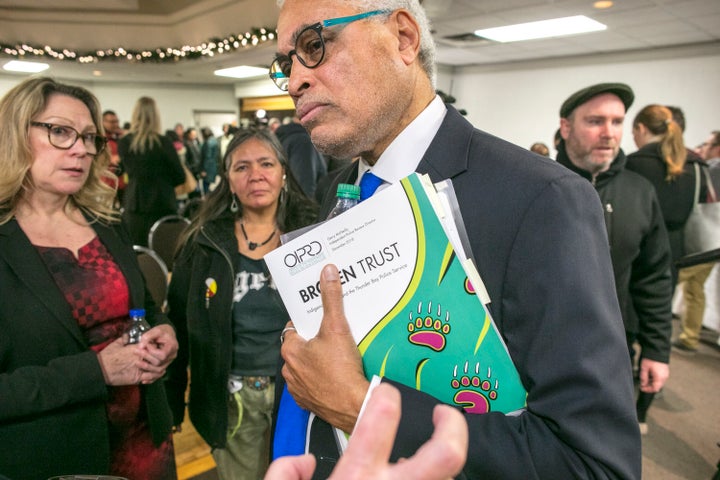
A whirlwind of questionable police tactics against Indigenous people made headlines across Canada over the last two weeks, building demand from Canadians to see real change in how police conduct themselves.
“This is definitely a rare moment,” Ryerson University criminology Prof. Tammy Landau told HuffPost Canada. “I have not seen such widespread discussion about transforming police as I have now.”
However, Canada’s highest ranking police officials refused to acknowledge that systemic racism is a problem within the RCMP — a “disheartening” stance, said Landau.
RCMP Deputy Commissioner Curtis Zablocki told reporters Monday, “I don’t believe [racism] is systemic through policing in Alberta.”
Top Mountie, Commissioner Brenda Lucki, told the Globe and Mail on Wednesday, “I have to admit, I really struggle with the term ‘systemic racism.’ I think that if systemic racism is meaning that racism is entrenched in our policies and procedures, I would say that we don’t have systemic racism.”
After widespread criticism, she walked back her statement.
On May 29, B.C.’s police watchdog recommended that five RCMP officers be criminally charged in relation to the death of a First Nations father of three, Dale Culver, in 2017. That recommendation came just days after George Floyd, a Black man killed by a white police officer during an arrest in Minneapolis, sparking protests across North America calling out systemic racism and police brutality.
Then on June 3, a video surfaced showing an RCMP officer knocking over an Inuk man with the door of a police truck in Nunavut. The next day, Chantel Moore, an Indigenous mother, was shot and killed by New Brunswick police during a wellness check. Both of these cases are being externally reviewed.
“That’s the tip of the iceberg,” said Aluki Kotierk, president of Nunavut Tunngavik Inc., the organization that represents the territory’s Inuit. For every case of alleged police misconduct that’s caught on video or reported in the news, she said she hears of several more. And mistrust of the RCMP — a force created to control Indigenous people — runs deep in those communities.
Mounties forced Indigenous people, including Inuit, onto reserves, and removed Indigenous children from their homes to send them to residential schools. They slaughtered thousands of sled dogs in an attempt to destroy Inuit’s way of life, and then denied it for decades.
“Many of us grew up with a fear of the RCMP and what is it they’re going to do?” said Kotierk. “You walk in your community, and you see the RCMP drive by. And you take stock of what has happened. Are they looking at you? You hear a knock on the door and you think, ‘oh my goodness, who is that, is that the RCMP?’”
Watch: Dashcam footage shows First Nations Chief Allan Adam punched during RCMP arrest. Story continues below.
Last weekend, First Nations Chief Allan Adam told reporters he was beaten during an arrest by Alberta RCMP over expired licence plates. Dashcam video of the incident was released Thursday, and shows an officer charging Adam, tackling him to the ground and punching him in the head.
Alberta’s police watchdog launched an investigation after Adam went public.
“Like many people, I have serious questions about what happened,” said Prime Minister Justin Trudeau at a news conference Friday, calling for the investigation to be independent and transparent. He’s pushing for all police in Canada to wear body cameras, and for systemic change to combat racism.
“At the same time, though, this is not an isolated incident. Far too many Black Canadians and Indigenous people do not feel safe around police. It’s unacceptable and as governments we have to change that.”
On Friday, RCMP in New Brunswick shot and killed a man from the Metepenagiag Mi’kmaq Nation, identified by family and friends as Rodney Levi. Police said they were responding to a call about a disturbed person and said Levi was holding a knife. Quebec’s police watchdog is now investigating.

This moment is by no means Canada’s first. In recent decades, a plethora of studies, reports and inquiries have detailed persistent and deliberate human rights violations of Indigenous people by police, including the National Inquiry into Missing and Murdered Indigenous Women and Girls, that have resulted in Indigenous people being over-policed and underprotected.
Indigenous people are 10 times more likely to be stopped and checked by police in Edmonton than non-Indigenous residents. In Winnipeg, 11 out of 19 people killed by police from 2000 to 2017 were Indigenous.
Across the country, Indigenous adults represent only 3 per cent of Canadians, but account for 30 per cent of the inmate population in 2020 — an all-time high, reported the Office of the Correctional Investigator. Indigenous women represent 42 per cent of female inmates.
Here are some of the most widely publicized incidents involving police use of force against Indigenous people in Canada in the past five years:
2015
- A video of an RCMP officer pinning a Yukon First Nations man to the ground and punching him went viral on Facebook. The man is heard saying “I’m doing nothing. Why are you hitting me?” while the officer held him to the ground. The officer was reassigned.
- CBC News uncovered an incident from 2011 that involved a Manitoba RCMP officer taking an intoxicated Indigenous woman out of a cell and driving her to his home to “pursue a personal relationship.” Fellow officers at the detachment either turned a blind eye or egged him on. An internal investigation resulted in him being docked seven days pay.

2016
- Dozens of Indigenous women in Val d’Or, Que. reported sexual and physical abuse by provincial police officers. Out of 54 complaints, one retired police officer was criminally charged, and he pleaded guilty to a single count of sexual assault.
- Debralee ChrisJohn died in police custody in London, Ont. from a heart attack following a methamphetamine overdose. An Ontario Provincial Police officer was convicted of criminal negligence causing death because he failed to call in a medical emergency despite signs she was in distress. He didn’t take any action until she was found unconscious in the cell.
- Deborah Campbell saw Vancouver police stop and arrest her 19-year-old son and accused him of being involved in a recent assault. When Campbell tried to ask why her son was being arrested, police physically removed her from the scene and told her to go home. Campbell’s son was later released from custody because police had no reason to hold him. The B.C. Human Rights Tribunal would rule that the police had discriminated against Campbell because she was Indigenous.
Watch: Prime Minister Justin Trudeau vows to work with Indigenous people. Story continues below.
2017
- Human Rights Watch reported to the federal government dozens of cases of male police officers conducting degrading strip searches and using excessive force on Indigenous women. The report also found that women who reported domestic violence to police faced skepticism and victim blaming. Police would often arrest them for actions taken in self-defence, it also stated.
- Brydon Whitstone, a member of Onion Lake Cree Nation, was unarmed when a Saskatchewan RCMP officer shot him. He had refused to exit his car following a police pursuit. At an inquest, a jury determined the officer should have used a Taser before a gun.
2018
- A video emerged of a Thunder Bay police officer hitting an Indigenous teen in the face and forcefully pushing her onto a stretcher. The police officer was charged under the Police Services Act with two counts of unnecessary exercise of authority.
2019
- The deaths of at least nine Indigenous people in Thunder Bay were re-opened after a police watchdog found the Thunder Bay Police investigations were inadequate due to racial stereotyping.

- Elliot McLeod, a homeless Indigenous man, was forcefully arrested in Edmonton by police officers. McLeod screamed in pain and begged them to stop, according to a video of the arrest. “Do not not run from the police,” one of the officers shouted at him. “Did you think I wouldn’t catch you?”
- Maxwell Johnson and his 12-year-old granddaughter went to a bank in Vancouver to open a savings account when an employee called police fearing a case of fraud. Johnson was arrested and handcuffed by police. He and his granddaughter were placed in the back of a police cruiser until the officers confirmed their identities and they were released. Police conduct is being investigated.
- An Indigenous teen was pushed to the ground by an OPP officer in Sioux Lookout, Ont. where she appeared to lay unconscious, according to a video. Two officers dragged her body into a police cruiser. She had two large gashes on her face and a bruise over her left eye. She was charged with three counts of assault.
- APTN released a video from 2012 that showed an Indigenous woman, who was attempting to report a sexual assault, being interrogated by an RCMP officer in Kelowna, B.C. “Were you turned on by this at all? Even a little bit?” the officer asked. “You understand that when a guy tries to have sex with a female and the female is completely unwilling, it is very difficult.” No charges were laid in relation to the sexual assault, and the girl reached an out-of-court settlement with the RCMP this year.